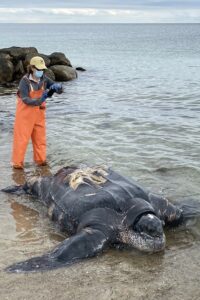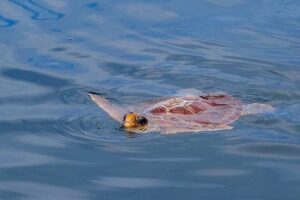WELLFLEET — Rising North Atlantic Ocean temperatures are causing increased numbers of threatened and endangered sea turtles to migrate through Massachusetts waters — heading north in search of food, then back south to their breeding grounds.
Their journey is fraught with dangers: fishing gear entanglement, plastic pollution, and habitat loss all threaten their survival, according to numerous environmental and fisheries sources. An additional menace looms large here at this time of year: the summer surge in boating traffic around Cape Cod.

“Vessel strike is a primary cause of sea turtle fatality in our waters,” said Karen Dourdeville, sea turtle research coordinator at Mass Audubon’s Wellfleet Bay Wildlife Sanctuary. Boats frequently collide with sea turtles as they come up for air after diving for food, she said.
August and September are peak months for boat strikes here, said Dourdeville, as vessels and migrating sea turtles are both heading south to the Caribbean and Central America.
Bob Prescott, founder of Wellfleet Audubon’s turtle program and the sanctuary’s director emeritus, said the loggerheads hug the shore as they travel south along the coast, which heightens their chances of interacting with boaters.
Leatherbacks are “feeding machines,” said Dourdeville. They are driven by appetite and typically found in areas of upwelling, where nutrient-rich ocean waters attract their preferred food, gelatinous organisms like jellyfish. She said their intense focus on food often makes them oblivious to boat traffic.
Dourdeville said among the five sea turtle species seen in Cape Cod waters — all protected under the Endangered Species Act — loggerheads and leatherbacks are particularly susceptible to collisions because of their size. Leatherbacks, listed as endangered, are the world’s largest turtle species, reaching up to eight feet in length and weighing up to 1,500 pounds, while loggerheads, listed as threatened, can grow up to 350 pounds.
So far this year, eight sea turtle fatalities have been reported to Mass Audubon, including four loggerheads and one leatherback being hit by vessels. The number of stranded sea turtles washed ashore after boat collisions varies each summer. Dourdeville said Mass Audubon’s highest recorded number was 37 in 2018.
It’s clear that rising ocean temperatures are pushing the loggerheads farther north to feed, said Samir Patel, a senior research biologist at the Coonamessett Farm Foundation, based in East Falmouth, which conducts surveys on marine resources, including turtles.

“We’re pretty much at one of the northern edges for a lot of these sea turtle species,” Patel said. He estimated there are currently 1,000 loggerheads in Massachusetts waters.
Mass Audubon lacks detailed current data for the total number of sea turtles in the area. While there have been a few aerial surveys, the high cost and the potential for underestimation pose challenges, said Dourdeville. In addition, smaller sea turtles are hard to detect as they spend limited time at the surface and are difficult to spot from an aircraft.
Patel named some other reasons turtles haven’t effectively adapted to avoid boats. “Their hearing is very low frequency, and it is not their primary sense for response, as they are visual predators,” he said. “It’s very hard for them to pinpoint the directionality of a boat.”
Sea turtles’ breathing patterns limit their ability to quickly respond to an oncoming boat. “They’ll inhale a lot of air so that they can float very easily,” Patel said. “If they inhale too much air and then need to respond quickly to a threat, they can’t release that air fast enough, causing them to bob back to the surface,” Patel said.
Boats of all sizes threaten turtles. A strike by a large fishing vessel traveling at 10 to 12 knots and one by a smaller pleasure craft speeding at 20 to 30 knots can both be fatal, said Patel. The risk of turtle strikes increases on busy summer weekends in Cape Cod Bay with commercial and recreational vessels crowding the waters.
Patel collaborates with the sanctuary’s sea turtle program and conducts necropsies on the animals. “For loggerheads, we see blunt force wounds where the carapace has cracks or large sections are shattered,” Patel said. “Leatherbacks are a little softer and often exhibit successive cuts in their carapaces, likely caused by propellers.”
Turtle populations are female dominant so there is a higher proportion of females compared to males. And Prescott noted the generational losses that come when a juvenile or an adult female turtle that might have lived 50 or 60 years is killed.
The Audubon team encourages boaters to assign a lookout at the front of their boats. “From now through the fall, we don’t want vessel operators to cruise our waters on autopilot,” said Dourdeville.
The Wellfleet sanctuary asks boaters to report turtle sightings to its hotline; the information helps the team determine turtles’ migration routes. “We look at the sightings and strandings, and now we have a lot of satellite data from the rehabilitated turtles, so we’re starting to get a better sense of where hard-shell turtles are primarily hanging out during July and August,” said Prescott. “We will then know where to tell people to go slower in their boats.”
The boater sighting data indicate a new migration trend this summer: leatherback sea turtles are staying farther offshore, near the southeast coast of Nantucket. This shift may reduce their vulnerability to boat strikes, Dourdeville said, but she cautioned that it is early still, with the peak months for boat strikes on turtles just beginning.



